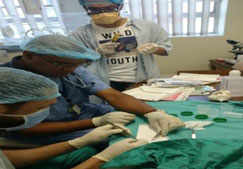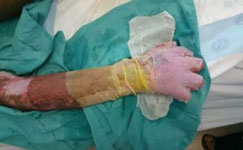South African doctor makes skin graft breakthrough
28 May 2015
Until recently the outlook for patients in South Africa with extensive burns was
bleak. The best they could hope for were highly specialised transplant techniques,
depending on the availability of resources.
If they survived, patients faced long and excruciating hospital stays, with mixed
results at the end of their treatment, alongside a very substantial bill. In some
cases the total cost of skin grafting can be up to R1.8-million.
A new technique developed by doctors at Tygerberg Hospital is now challenging this
prognosis for serious burn victims, offering life-saving, viable and affordable
treatment and making their previously bleak outlook much brighter.
Dr Wayne Kleintjes, the head of the adult burn unit at Tygerberg Hospital,
developed the new technique. It makes use of the patient's own skin, which is then
externally cultivated in a laboratory from skin harvested via a skin biopsy. Other
options, using skin
from donors or other species are soon rejected and have proven
to be of limited value.
The new technique is remarkable in the sense that it offers patients treatment at a
fraction of the cost that similar techniques would normally cost. "With our new
technique, we treated the first patient with a total cost of R995," Kleintjes said.
The procedure
The technique is not entirely new, but the culture method differs dramatically from
others in its simplicity, effectiveness, biological safety and modest cost. The
technique costs about R1 000; comparable treatment using existing methods could
stretch to R1.8-million. A great advantage is that no immunosuppressant drugs are
needed because the patient's own skin is used.
Kleintjes explained that the technique was revolutionary because no expensive and
extensive laboratory equipment was needed. "We can now grow skin in the room
next to the patient," Kleintjes said.
"The simplicity of
the technique, the cost-effectiveness and the effectiveness is
comparable to other skin culture techniques and also important is the fact that it is
absolutely biologically safe. This makes it very suitable for use in a third world
country," he said.
"You need a skin biopsy from the patient," he explained the technique in broad
brushstrokes. "The skin is then cut up in smaller pieces, then you grow the skin for
14 days. Once the skin has grown out in layers, you can place it on the patient."
Biologically safe
It differed from the well-known Epicel technique – the technology that was used for
young burn patient Pippie Kruger – in that with Epicel the skin was cultured in a
major laboratory. "The skin cells are grown on mice cells. With our technique you
don't need expensive laboratory equipment. No animal material is used, making it
biologically safe."
Western Cape Health MEC Nomafrench Mbombo was excited that the new technique
would make access for patients to this innovation possible. It would help to treat
many patients.
"In the Western Cape we have a lot of shack fires. There is a great need," she said.
Speaking at a press briefing announcing the breakthrough, Kleintjes said that in
most cases, burns covering more than 30% of the total body area were life-
threatening. "Patients will certainly benefit from this new technique."
Two patients already treated
This new technique, which Kleintjes called the "Tygerberg Burns Unit technique",
has been successfully used in the past year on two patients. A 16-year-old boy was
discharged from the intensive care unit only two weeks after receiving the
transplant and the second patient, who had 63% total body surface area burns, was
out of the unit in four weeks.
Full application was made to Stellenbosch University's Health Research Ethics
Committee in 2014 to request that the procedure be extended to help
other
patients.
Inspiration from patient
Kleintjes said the idea for the new technique came while he was treating the 16-
year-old, who was burned following an assault. The patient was in intensive care for
three months and his condition was rapidly deteriorating.
"He was basically just skin and bones," Kleintjes said. "It was not possible to
operate on the patient because he was too weak. The only resort was to use
cultured skin, but unfortunately the Epicel product was not available due to an
import ban."
Kleintjes said he prayed out of desperation to save his patient's life. "Fortunately,
God gave me insight into the new technique."
The boy is now in the general burns ward.
Affordability hopes
The exact details of the new culture technique have not yet been made public.
Kleintjes said he hoped it would not be commercialised. "There is a risk that
companies will make this technique available at a
price. For us in third world
countries, with lots of burn patients, price is very important," he said.
"I know that, if you are not careful, people can copy the technique and sell it at a
high price. This will defeat the purpose of making it available as a cost-effective
way to save many patients."
The doctor said he was awaiting final feedback on the pending patent for the
technique.
A host of other techniques are available, but none of them prove to be cost-
effective. This is particularly important in this country, where the South Africa
Medical Research Council estimates that approximately 3.2% of the adult population
suffer from thermal injuries a year.
The Western Cape Department of Health stated that "the primary goal with the
method is to save the patients' lives. The secondary goal is to do it safely and
within budget."
"We are very proud of our clinicians; their relentless quest for excellence and their
spirit of
innovation," said Dr Beth Engelbrecht, the head of the department.
Source: News24Wire
 The skin biopsy of 7x3 centimetres was taken from the hip area of the patient. (Image: Western Cape Department of Health)
The skin biopsy of 7x3 centimetres was taken from the hip area of the patient. (Image: Western Cape Department of Health)
 The next day of the xenograft, EZ Derm, in the intensive care unit. (Image: Western Cape Department of Health)
The next day of the xenograft, EZ Derm, in the intensive care unit. (Image: Western Cape Department of Health)




